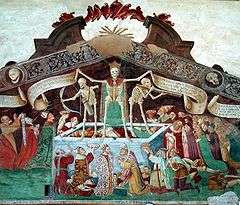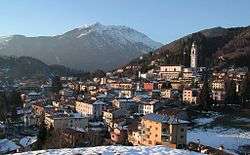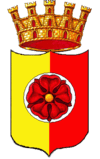Clusone
| Clusone | ||
|---|---|---|
| Comune | ||
| Città di Clusone | ||
|
Panorama of the town in winter | ||
| ||
 Clusone Location of Clusone in Italy | ||
| Coordinates: 45°53′N 9°57′E / 45.883°N 9.950°E | ||
| Country | Italy | |
| Region | Lombardy | |
| Province / Metropolitan city | Bergamo (BG) | |
| Frazioni | Fiorine | |
| Government | ||
| • Mayor | Paolo Olini (PdL-Lega Nord) | |
| Area | ||
| • Total | 25 km2 (10 sq mi) | |
| Elevation | 647 m (2,123 ft) | |
| Population (31 December 2004) | ||
| • Total | 8,461 | |
| • Density | 340/km2 (880/sq mi) | |
| Demonym(s) | Clusonesi | |
| Time zone | CET (UTC+1) | |
| • Summer (DST) | CEST (UTC+2) | |
| Postal code | 24023 | |
| Dialing code | 0346 | |
| Patron saint | Saint Blaise e Saint John the Baptist | |
| Saint day | February 3 and June 24 | |
| Website | Official website | |
Clusone (Clüsü in Bergamasque dialect) is an Italian town and comune in the province of Bergamo, Lombardy, Italy. Located in the Val Seriana, it received the honorary title of city on 15 May 1957 with a presidential decree which ratified a Napoleon's promise of the year 1801.
Geography and climate
Clusone is part of the Serio Valley, even though from a orographic point of view the plateau of Clusone, from glacial origin, belongs in part to the basin of Oglio.
The climate of Clusone is temperate: in the winter, temperatures can fall to −5 °C (23 °F) and in summer may reach a maximum of 25 °C (77 °F).
History
Antiquity and Dark Ages
The city is of classical origin, probably dating back to the first settlement of Orobi which was founded in 1300 BC.[1]
Later, in the Roman period, important settlements occurred that made the village a center of greater importance in the entire district, including the construction of fortifications. The city's name originates from this period and may come from the Latin word clausus, indicating an enclosed space surrounded by mountains
The following centuries saw the end of Roman domination and the subsequent arrival of the Lombards, who were in turn followed by the Franks, who created the basis for the formation of the Holy Roman Empire and whose rulers determined the fate of the country throughout the entire medieval period.
The first written document which mentions Clusone dates from 774, in a deed that recorded the grant of the nucleus of the Rocca fortress by Charlemagne to the monks of San Martino di Tours. The fortress in question grew considerably in medieval times, so as to assume the appearance of a real castle, with walls and towers for defensive purposes.
A branch of the noble Aliprandi family of Milan, that assumed the surname Fanzago in place of that original, moved to Clusone at the end of the 14th century.
The Modern and Contemporary Period
The next accession to the territories of the Republic of Venice represented the period of maximum artistic, cultural and commercial development, permitting the achievement of a high degree of wealth. Clusone shared its fate with Venice until the treaty of Campoformio when it joined the Cisalpine republic.
After the allocation of these territories to the Austrians, the small city was placed within the kingdom of Lombardo-Veneto, under which Clusone became the chief city of a district of the province of Bergamo.
On November 12, 1801, it was awarded the title of city, for the richness of buildings reminiscent of its glorious past. This title was reconfirmed on May 15, 1957, by the Italian Republic.
Monuments and places of interest
Piazza della Rocca
Until the 19th century, the city was surrounded by walls, and there is documented evidence that in more distant times it was even with equipped with a fortress which still remains precisely marked out in the Piazza della Rocca. The streets of the city are mainly sloped according to the slope on which it stands: on the highest road stands the monumental basilica of Santa Maria Assunta, established in the eighteenth century, whose high bell tower is visible from the entire valley.
Oratorio dei Disciplini
In front of the facade of the basilica is the Oratory of Disciplini, which has a fresco on the facade from the 15th century with the Triumph of Death on top and a macabre dance of great interest in the lower register.

Outside of the "Oratorio dei Disciplini" is a fresco of the The Triumph of Death painted by Giacomo Borlone de Buschis in 1485. It portrays a triumphant Death, personified as a living skeleton with a cloak and a crown. At her feet are the bodies of a pope and an emperor, surrounded by snakes, frogs and scorpions. She stands on a sepulchre around which figures of a cardinal, a bishop, a king and a philosopher are offering her gifts. She is flanked by two skeletons who fire against other characters at the side, one with a bow and another, on the right, with an early arquebus.
Three inscription and cartouches decorate the painting. On the left of the Queen Death they say:
Ognia omo more e questo mondo lassa - chi ofende a Dio amaramente passa (Everyone dies and this word lets - Who offend God bitterly goes)
On the right:
O ti serve a Dio del bon core non avire pagura a questo ballo venire. Ma alegremente vene e non temire (For the love of God don't have fear to come at this dance. But joyfully you come and be happy)
The lower inscription is in Latin:
... Amus crucem omnes diligamus Deo devote serviamus cum omne reverentia
Other sections of the cycle include the Meeting of the Three Alive and Three Dead Menand a Danse Macabre. The latter marching skeletons with characters of lower rank than the ones in the Triumph.
The basilica is located in a dominant position over the area, and the south side towards the city has a portico with arches and columns that overlook a spectacular staircase, decorated with balustrades and four large statues of the evangelists.
Others
On the street at the level immediately below are the most important civic buildings, including the town hall, with its facade covered with late-Gothic frescoes and with the clock tower.
The lower street is on the other hand predominantly commercial, while the bottom one, next to the place where the walls stood, is made up of buildings with the typical balcony structure of originally agricultural assignment.
Among the most interesting buildings there is the church and the Court of Sant'Anna.
Other important churches include the Church of Heaven, containing a painting by Marco Richiedei, which is located near Piazza Uccelli and the church of San Defendente, both from the 15th century.
Other buildings of particular importance are the Fogaccia Palace, built in the 17th century, with large halls that exhibit valuable paintings (including those of the Clusonesi Carpinoni Domenico and Antonio Cifrondi) and frescoes by the painter Francesco Paglia (between the seventeenth and eighteenth centuries), and the Town Hall. The latter is adjacent to the Clock Tower and is considered the symbol of the city.
The clock in question, the work of Pietro Fanzago, is still used today and reports astral movements of the earth, the sun and the moon, all with the greatest precision.
In the 19th and 20th centuries, the town also saw the construction of a certain number of buildings inspired by the Art Deco architectural form, among which one picks the Palazzo Carrara Spinelli Maffei in which Calra Maffdei held important meetings in the time of the Risorgimento.
Twin towns — Sister cities
Clusone is twinned with:
-
 Le Raincy, France
Le Raincy, France
External links
![]() Media related to Clusone at Wikimedia Commons
Media related to Clusone at Wikimedia Commons

